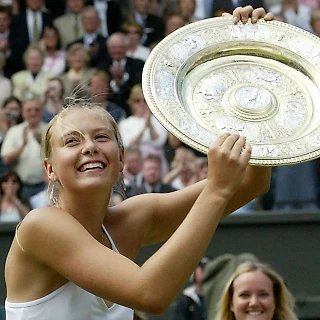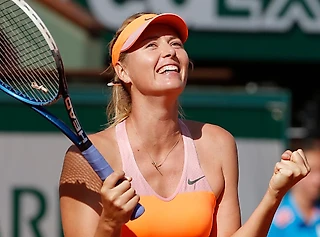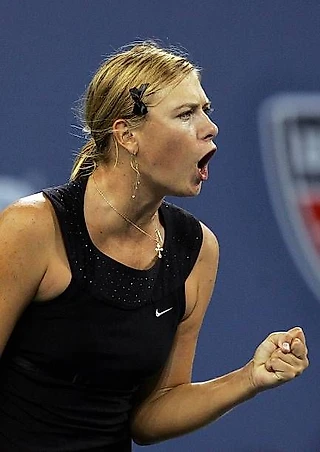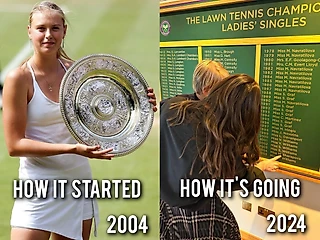Sharapova's Master Plan To Beat Serena
By TOM PERROTTA
Wimbledon, England
When Maria Sharapova plays her second-round match at Wimbledon this week, people will marvel at her power, gawk at her good looks and perhaps crack a few jokes about her shrieks. But they'll ignore the real Sharapova entirely.
Of all the women on the tour today, none has done more to adapt to the sport's evolution, and her own physical gifts and liabilities, than Sharapova.
There was the unexpected growth spurt and the need to add muscle to her lean frame, which cost her some speed. And the shoulder surgery that forced her to retool her serve, which robbed her of an essential weapon for several years. As tennis shifted from the power era of Venus and Serena Williams and Lindsay Davenport, to the über-athlete era of Justine Henin and Kim Clijsters, and finally to today's game, where spin and depth are increasingly blended with power, Sharapova has adjusted her approach to keep pace.
"Everyone thinks Maria is just a ball basher, but I don't care who you are, you don't have the career she's had by just hitting the ball and not thinking," said Michael Joyce, her former coach.
In the last few months, Sharapova has hired a video-analysis expert to help her solve the enduring riddle that is Serena Williams, who has beaten her 13 straight times since 2005, most recently in the French Open final. It's an investment in technology that few top tennis players have made, despite advances in the field.
"She still has a mission to beat Serena," said Thomas Högstedt, her current coach, after the French Open final. "She knows what she has to do, but she still has to believe a little bit more in it."
Sharapova's rivalry with Williams picked up intensity last week, after a Rolling Stone article quoted Williams talking critically about a top-five player and her boyfriend, a couple the article's writer guessed was Sharapova and Grigor Dimitrov. In a pre-Wimbledon news conference, Sharapova responded with comments on Williams's presumed relationship with her coach, Patrick Mouratoglou. Sharapova declined to speak further about the spat after her first-round victory Monday. "I've said everything that I wanted to say about the issue," she said.
Before the French Open, Craig O'Shannessy, a coach based in Austin, prepared video clips and a report on Williams for Sharapova's camp, at its request, he said. After the French Open final, he followed up with more clips and analysis. "The game evolves, opponents evolve and the game plan must evolve," O'Shannessy said.
O'Shannessy's videos show patterns that work—and fail—against Williams. He calls the open court "an illusion," because Williams excels at being aggressive while moving to the open court. The solution: Hit behind Williams as often as possible, forcing her to move in one direction, reset her feet, and then go back in the other direction.
Opponents look to attack Williams's forehand crosscourt, since that's where she makes most of her errors. Still, Sharapova too often takes risks down the line, O'Shannessy said, especially from defensive positions. And she hits too many backhands from the middle of the court, when she has time to sidestep and hit forehands.
This isn't the first time Sharapova has relied on video. At the 2006 U.S. Open, she went into the final against Justine Henin having lost their last four matches, including their semifinal at that year's Australian Open. Joyce's father, a former photography director for television shows such as "Little House on the Prairie" and "CHiPs," scoured Henin video to suggest tactics for Sharapova.
"Henin had extreme grips," Joyce said. "My dad said, 'If Maria can hit down the middle and make her switch grips as often as possible, she'll get more errors.'" Sharapova won, 6-4, 6-4.
While Williams poses a bigger challenge than Henin, Sharapova's toughest opponent has been her own body. When she beat Williams in the 2004 Wimbledon final, the 17-year-old Sharapova wasn't as tall, and she was rail thin. "She was a little girl," Joyce said.
She was more aggressive than Williams, too, and had a stronger serve. Sharapova's second serve averaged 97 miles per hour in that match, compared to 86 mph for Williams. She slugged second serves and won 71% of those points, and she hit startling winners on the run. Sharapova is now taller, and heavier by necessity: It takes muscle to stay healthy and maintain power. She can't hit on the run quite as well.
"I don't think she's every going to defend as well as she did when she was 17 or 18, because her body won't allow it," Joyce said.
The same goes for her serve. Back then, Sharapova had a lower toss and a more violent motion with a deeper knee bend; she didn't hit up and out on the ball, as the best servers do. She just attacked it straight on, which put stress on her shoulder. Her current serve is modeled on the "shoulder over shoulder" technique that has spared many shoulders from injuries. But she doesn't hit it with as much abandon since she had surgery in 2008.
Since Sharapova began working with Högstedt, she has improved her footwork and fitness, and worked on taking control of points as soon as possible so there's less running to do.
"The women's game has improved extremely in the last two years—not many realize," Hogstedt said, citing the general pace and intensity of rallies. "The one who controls the first shot almost all the time wins the point."
Right now, that woman is Williams, but don't bet that Sharapova can't adapt. She has been doing it for years.
A version of this article appeared June 25, 2013, on page D6 in the U.S. edition of The Wall Street Journal, with the headline: Sharapova's Master Plan To Beat Serena.









Совершенно верно говорите, Томас, но почему Мария не контролирует первого удара, когда и Вы утверждаете что тот кто контролирует первый удар почти всегда выигрывает очко? Почему Мария не атакует первой? Здесь на блоге мы говорим об этом уже годы!